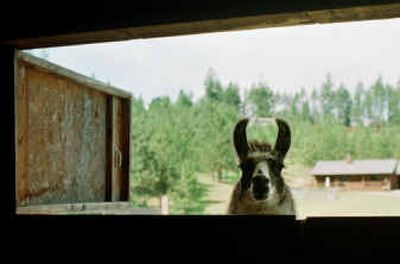Urban animals on display

Barns will be crowded with critters this year to show off the best of North Idaho livestock.
Most of the livestock comes with 4-H kids involved in raising and breeding animals. 4-H members learn how to care for animals during the year and compete with other kids at the fair.
But other than 4-H stock, open stock is shifting to less traditional animals, such as llamas and rabbits, said Chris Holloway, general manager for the North Idaho Fair.
“We’re just becoming more urban and we’re not as agricultural as we used to be,” she said.
Holloway said open stock for cattle, draft horses and other large animals are less common and the livestock shows that dominated the past aren’t likely to return. However, she said as long as 4-H remains a strong program, livestock at the fair will remain a big part of its main attractions.
In the interim, the fair is looking for new ways to keep animals on display.
“We try to have things or offer things that promote agriculture, or for small children to learn about agriculture so they know it’s important, so they know where our food comes from,” she said.
Kids also learn about other gifts from the animal kingdom, such as wool from sheep and llamas, an animal that probably wasn’t anywhere near Coeur d’Alene for the first county fair. Llamas also are useful for packing equipment, cart driving or recreational packing.
Chuck Riley, a llama owner and breeder in Coeur d’Alene, started the fair’s llama department in 1999.
He started off by showing Rocket, a national grand champion, to build interest and attract other llama owners to the fair.
The category has grown in the last five years and provides an educational experience for kids and adults.
Some llama owners open up the competition and let bystanders show the animal by leading it through an obstacle course.
Riley said the hands-on interaction helps build interest in llama ownership.
“In my opinion, that’s what the fair’s all about,” he said.
Riley has owned llamas since 1988 after retiring from the Navy. He started a breeding business to supplement his income, but is slowly getting out of the business. He owns a dozen llamas, down from a high of about 60, and is passing his role as superintendent of the llama department to Dave Stone of Rathdrum.
Stone started raising llamas in 1990 and has six so far, which he uses on recreational hikes and displays for schoolchildren. He said the animals are smart, curious and friendly, making it easy to compete without much guidance.
“Most people describe them as a regal animal, a royal looking animal, with big eyes,” he said. “They just win your heart.”
Llamas are shown in a halter class and judged on conformation, quality and bone structure. They also trek through an obstacle course and packing demonstration.
Stone said the fair is also a good form of advertising to let people know about the animals and build a reputation as a breeder. Some owners aim for a name in fur quality, too.
“We do it for fun,” he said. “It’s fun to show your animal and get a ribbon.”
He added kids are getting involved with a growing youth group of llama owners outside the 4-H program.
Raising the animals takes skill and some knowledge gained only through years of breeding, said Riley.
“You can look at them as companion, but in terms of taking care of them, it’s still a large animal,” he said.